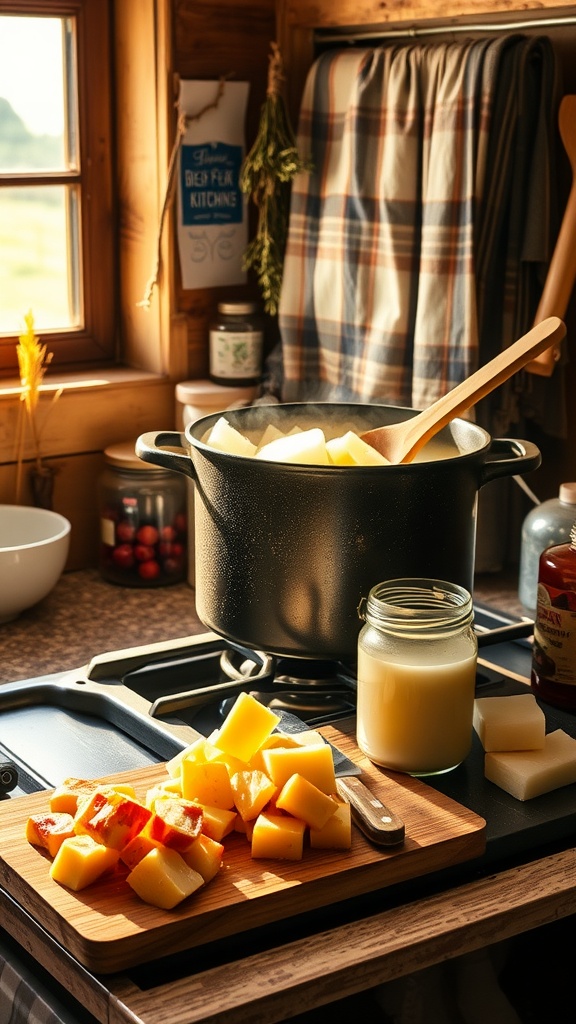If you’ve ever wanted to learn how to make your own beef tallow, you’ve come to the right place. This recipe is a staple in many rustic farmhouse kitchens, offering a rich and flavorful fat that can elevate your cooking. Picture a cozy kitchen bathed in warm, natural light, where the aroma of beef fat melting fills the air, creating a welcoming atmosphere.
Making beef tallow is not just practical, it’s a culinary adventure that connects you to traditional cooking methods. With just a few simple ingredients, you can transform raw beef fat into a creamy, golden substance that’s perfect for frying, baking, or adding flavor to your favorite dishes.
Creating a Cozy Kitchen Atmosphere
Envision a kitchen that radiates warmth, where natural light pours in, creating a welcoming space. The rustic farmhouse aesthetic is brought to life with wooden accents and vintage appliances, reminiscent of simpler times.
Here, the heart of cooking beats steadily as a large cast-iron pot gently simmers on a vintage gas stove. Its surface is adorned with melting chunks of beef fat, releasing rich aromas that fill the air. The calming ambiance invites you to linger and enjoy the process.
The Art of Rendering Beef Fat
Rendering beef fat is a culinary technique steeped in tradition. It transforms raw fat into a versatile cooking companion known as tallow. The process begins by carefully trimming any excess meat or connective tissue from the beef fat and cutting it into small, uniform chunks.
This preparation ensures even melting, making the rendering process smoother. As the chunks are added to the pot, patience is essential. Over low to medium heat, the fat will gradually melt, releasing flavorful oils while separating from solid bits.
A Sensory Experience
As the beef fat warms, the gentle bubbling and sizzling sounds create a soothing atmosphere. Stirring occasionally with a wooden spoon, you can almost feel the connection to generations of cooks who have made tallow in their kitchens.
In the background, dried herbs hang, adding a rustic touch and hinting at the flavors that will soon accompany the tallow in future dishes. The interplay of scents, sounds, and sights transforms this kitchen task into a delightful ritual.
Straining and Storing Tallow
Once the fat has completely melted, it’s time to strain it. Using a fine mesh sieve or cheesecloth, pour the liquid gold into a clean glass jar, leaving any solid remnants behind. This step is crucial, as it ensures a smooth texture, free from impurities.
Allow the tallow to cool before sealing the jar. This creamy substance can be stored in the refrigerator for up to a month or frozen for longer preservation. Each jar represents culinary potential, waiting to enhance your favorite recipes.
The Versatility of Beef Tallow
This homemade beef tallow is not just a cooking fat; it’s a multi-faceted ingredient that can elevate various dishes. With a rich, savory taste, it serves as an excellent base for frying, roasting, or even baking.
Whether you’re preparing classic comfort food or experimenting with new flavors, tallow adds depth and richness to every bite. Its smooth, creamy consistency makes it easy to work with in the kitchen, promising delightful results in countless culinary endeavors.
A Connection to Tradition
Making beef tallow connects you to a long-standing culinary tradition. This process is more than just rendering fat; it’s about honoring the practices of our ancestors. It reflects a commitment to using every part of the animal sustainably and creatively.
In a world where convenience often overshadows tradition, taking the time to render your own tallow brings a sense of accomplishment and a deeper appreciation for the ingredients we use. Embrace the rustic charm of your kitchen and enjoy the fruits of your labor as you create flavorful dishes with homemade beef tallow.
The Perfect Recipe for Homemade Beef Tallow

This homemade beef tallow is characterized by its rich, savory taste and versatility in the kitchen. It’s smoother and creamier than you might expect, making it an excellent choice for both cooking and baking.
Ingredients
- 2 pounds of beef fat, cut into small chunks
- 1/4 cup water (optional, to prevent sticking)
Instructions
- Prepare the Fat: Trim any meat or connective tissue from the beef fat, and cut it into small, uniform chunks to help it render evenly.
- Render the Fat: In a large cast-iron pot, add the beef fat and water if using. Heat over low to medium heat, stirring occasionally, until the fat melts and separates from any solids, about 1-2 hours.
- Strain the Tallow: Once the fat is fully melted, strain it through a fine mesh sieve or cheesecloth into a clean glass jar, discarding the solid bits left behind.
- Cool and Store: Allow the tallow to cool completely before sealing the jar. Store it in the refrigerator for up to a month or in the freezer for longer preservation.
Cook and Prep Times
- Prep Time: 15 minutes
- Cook Time: 2 hours
- Total Time: 2 hours 15 minutes
Nutrition Information
- Servings: Approximately 8 cups
- Calories: 115 per tablespoon
- Fat: 13g
- Protein: 0g
- Carbohydrates: 0g
